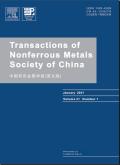Influence of processing history on microstructure, mechanical properties, and electrical conductivity of Cu−0.7Mg alloy
IF 4.7
1区 材料科学
Q1 METALLURGY & METALLURGICAL ENGINEERING
Transactions of Nonferrous Metals Society of China
Pub Date : 2025-04-01
DOI:10.1016/S1003-6326(24)66743-9
引用次数: 0
Abstract
The effects of forward extrusion as well as extrusion combined with reversible torsion (KoBo extrusion), followed by additional deformation via the MaxStrain module of the Gleeble thermomechanical simulator, on the microstructure, mechanical properties, and electrical conductivity of a Cu−0.7Mg (wt.%) alloy, were investigated. The simulation results highlighted the critical influence of processing history on determining the equivalent strain distribution. The sample subjected to forward extrusion at 400 °C and subsequent MaxStrain processing (FM sample), possessed 76% lower grain size compared to the sample processed solely with MaxStrain (AM sample). Likewise, the KoBo-extruded and MaxStrain-processed sample (KM sample) exhibited 66% smaller grain size compared to the AM sample. Tensile test results revealed that the AM, FM, and KM samples, respectively, possessed 251%, 288%, and 360% higher yield strength, and 95%, 121%, and 169% higher tensile strength compared to the initial annealed alloy, as a result of grain refinement as well as deformation strengthening. Finally, the electrical conductivity measurements revealed that AM, FM, and KM samples, respectively, possessed electrical conductivity values of 37.9, 35.6, and 32.0 MS/m, which, by considering their mechanical properties, makes them eligible to be categorized as high-strength and high-conductivity copper alloys.
加工历史对Cu−0.7Mg合金组织、力学性能和电导率的影响
研究了Cu−0.7Mg (wt.%)合金的正向挤压和可逆挤压结合变形(KoBo挤压),再通过Gleeble热机械模拟器的MaxStrain模块进行额外变形对合金显微组织、力学性能和电导率的影响。仿真结果强调了加工历史对确定等效应变分布的关键影响。经过400°C正向挤压和随后的MaxStrain处理的样品(FM样品),与仅用MaxStrain处理的样品(AM样品)相比,具有76%的晶粒尺寸降低。同样,kobo挤压和maxstrain处理的样品(KM样品)的晶粒尺寸比AM样品小66%。拉伸试验结果表明,由于晶粒细化和变形强化,AM、FM和KM样品的屈服强度分别比初始退火合金高251%、288%和360%,抗拉强度分别比初始退火合金高95%、121%和169%。最后,电导率测量显示,AM、FM和KM样品的电导率分别为37.9、35.6和32.0 MS/m,考虑到它们的力学性能,它们有资格被归类为高强度和高电导率的铜合金。
本文章由计算机程序翻译,如有差异,请以英文原文为准。
求助全文
约1分钟内获得全文
求助全文
来源期刊
CiteScore
7.40
自引率
17.80%
发文量
8456
审稿时长
3.6 months
期刊介绍:
The Transactions of Nonferrous Metals Society of China (Trans. Nonferrous Met. Soc. China), founded in 1991 and sponsored by The Nonferrous Metals Society of China, is published monthly now and mainly contains reports of original research which reflect the new progresses in the field of nonferrous metals science and technology, including mineral processing, extraction metallurgy, metallic materials and heat treatments, metal working, physical metallurgy, powder metallurgy, with the emphasis on fundamental science. It is the unique preeminent publication in English for scientists, engineers, under/post-graduates on the field of nonferrous metals industry. This journal is covered by many famous abstract/index systems and databases such as SCI Expanded, Ei Compendex Plus, INSPEC, CA, METADEX, AJ and JICST.

 求助内容:
求助内容: 应助结果提醒方式:
应助结果提醒方式:


